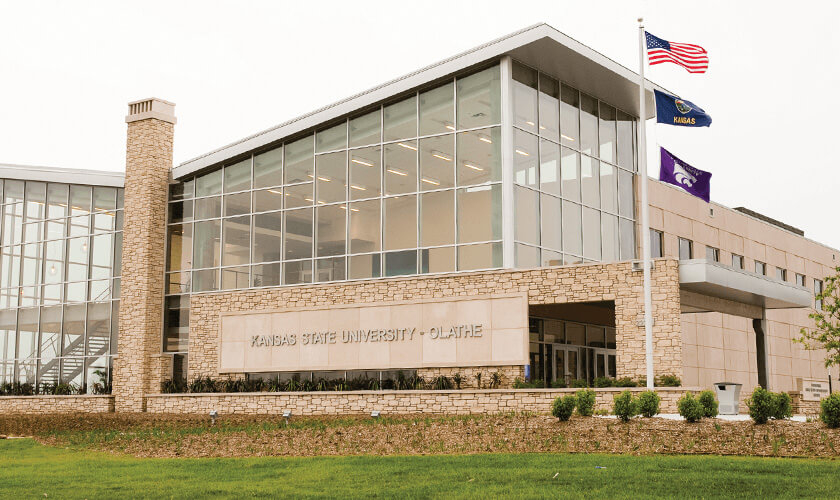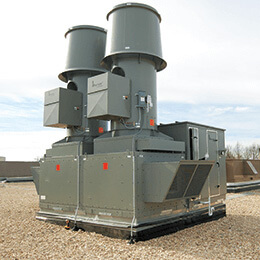Project Profile: K-State Olathe International Animal Health and Food Safety Institute

The Challenge
• Exhaust laboratory systems as needed to exhaust fumes and air high above surrounding buildings and away from air intake systems
• Exhaust cooking smoke, grease and air from kitchens to maintain indoor air quality
• Provide energy efficient ventilation equipment that would support LEED Silver Certification
• Support quiet, classroom and meeting space environment with low sound, efficient air movement
The International Animal Health and Food Safety Institute is the first building erected on Kansas State University's new 38-acre campus in Olathe, Kansas. Design-build construction of the $28 million facility began in November of 2009, and the building opened in April, 2011. It functions as a graduate-level campus, as well as a facility for research and outreach in the Kansas Bioscience Park. The 108,000 square-foot building includes classrooms, offices and ten laboratories for graduate students, university and industry scientists in the areas of food science, food safety, and animal health. Entrepreneurs, product developers and other business leaders converge at K-State Olathe to explore animal health and food safety commercialization opportunities, engaging assets from all three of the university's campuses. The multi-function building also features state-of-the-art kitchens used for food research, a sensory and consumer research center, and space that can be utilized for industry, community and educational meetings, conferences and training opportunities.
The building achieved LEED®-Silver Certification.
91����͵��’s Solution
• 2 91����͵�� Vektor-MD Laboratory Exhaust Systems with ERS Plenums
• 1 91����͵�� Vektor-H Laboratory Exhaust System
• 4 Centrifugal Upblast Exhaust Fans, Model CUBE
• 4 Centrifugal Roof Exhaust Fans, Model GB
Two 91����͵�� Vektor-MD laboratory exhaust systems with bypass plenums housing energy recovery coils were installed to exhaust laboratory fumes from the fume hoods while recovering sensible heat and cooling to pretreat incoming fresh air. The two Vektor-MD systems service the 10 fume hoods currently being used. One of the Vektor-MD systems is redundant to ensure uninterrupted service if needed and to accommodate additional demand as needed. As more laboratories are built and new laboratory hoods added, additional Vektor-MD laboratory exhaust systems can easily be installed without disruption to the laboratories themselves. A single Vektor-H laboratory exhaust system was installed in the waste containment area where a smaller quantity of exhaust needed to be propelled high above the building.
Energy efficient kitchen exhaust systems included four easy-to-clean and maintain 91����͵�� centrifugal upblast exhaust fans, Model CUBE. The spun aluminum fans feature a one-piece windband continuously welded to the curb cap and double studded isolators for true vibration isolation and quiet operation. Four 91����͵�� centrifugal roof exhaust fans, Model GB, were installed to handle ventilation for the central plant, restrooms and locker rooms. These fans also feature double studded isolators for true vibration isolation and quiet operation. 91����͵�� combination fire smoke dampers were utilized to meet local fire safety codes.
Other products included in this project were 91����͵�� Model BSQ centrifugal inline fans, Model MBD balancing dampers, Model FSD combination fire smoke dampers, Model EHH wind-driven rain extruded louvers and Model CSP direct drive inline cabinet fans.
The Results

